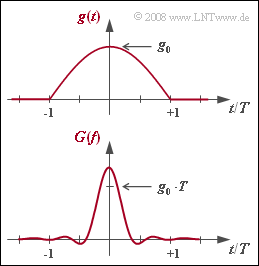Exercise 4.15Z: MSK Basic Pulse and MSK Spectrum
From LNTwww
The fundamental pulse that is always required to realize MSK as Offset–QPSK has the form shown in the graph above:
- $$g_{\rm MSK}(t) = \left\{ \begin{array}{l} g_0 \cdot \cos (\pi/2 \cdot t/T) \\ 0 \\ \end{array} \right.\quad \begin{array}{*{10}c} | t | \le T \hspace{0.05cm}, \\ {\rm otherwise}\hspace{0.05cm}. \\ \end{array}$$
The spectral function $G(f)$ is drawn below, that is, the Fourier transform of $g(t)$.
The corresponding equation is to be determined in this task, by considering:
- $$g(t) = c(t) \cdot r(t)\hspace{0.05cm}.$$
The following abbreviations are used here:
- $c(t)$ is a cosine oscillation with amplitude $1$ and frequency $f_0$ (yet to be determined).
- $r(t)$ is a square wave function with amplitude $g_0$ and duration $2T$.
Hints:
- This exercise belongs to the chapter Nonlinear Digital Modulation.
- Particular reference is made to the page Realizing MSK as Offset–QPSK.
- The result obtained here is also used in Exercise 4.15 .
Questions
Solution
(1) The period of the cosine signal must be $T_0 = 4T$ . Thus, the frequency is $f_0 = 1/T_0\hspace{0.15cm}\underline {= 0.25} · 1/T$.
(2) The spectral function of a rectangular pulse of height $g_0$ and duration $ 2T$ is:
- $$R(f) = g_0 \cdot 2 T \cdot {\rm si} ( \pi f \cdot 2T )\hspace{0.2cm}{\rm mit}\hspace{0.2cm}{\rm si} (x) = \sin(x)/x \hspace{0.3cm} \Rightarrow \hspace{0.3cm}R(f = 0) \hspace{0.15cm}\underline {= 2} \cdot g_0 \cdot T\hspace{0.05cm}.$$
(3) When $g(t) = c(t) · r(t)$ , it follows from the convolution theorem that: $ G(f) = C(f) \star R(f)\hspace{0.05cm}.$
- The spectral function $C(f)$ consists of two Dirac functions at $± f_0$, each with weight $1/2$. From this follows:
- $$ G(f) = 2 \cdot g_0 \cdot T \cdot \big [ 1/2 \cdot \delta (f - f_0 ) + 1/2 \cdot \delta (f + f_0 )\big ] \star {\rm si} ( 2 \pi f T )= g_0 \cdot T \cdot \big [ {\rm si} ( 2 \pi T \cdot (f - f_0 ) ) + {\rm si} ( 2 \pi T \cdot (f + f_0 ) ) \big ] \hspace{0.05cm}.$$
- Using the result $f_0 = 1/(4T)$ from question (1) , it further holds that:
- $$G(f) = g_0 \cdot T \cdot \big [ {\rm si} ( 2 \pi f T - \pi / 2 ) + {\rm si} ( 2 \pi f T + \pi / 2) \big ]$$
- $$\Rightarrow \hspace{0.3cm} G(f = 0) = g_0 \hspace{-0.02cm}\cdot\hspace{-0.02cm} T \hspace{-0.02cm}\cdot\hspace{-0.02cm} \big [ {\rm si} ( - \pi/2 ) + {\rm si} ( +\pi/2 ) \big ] = 2 \cdot g_0 \hspace{-0.02cm}\cdot\hspace{-0.02cm} T \hspace{-0.02cm}\cdot\hspace{-0.02cm} {\rm si} ( \pi/2 ) = 2 \hspace{-0.02cm}\cdot\hspace{-0.02cm} g_0 \hspace{-0.02cm}\cdot\hspace{-0.02cm} T \hspace{-0.02cm}\cdot\hspace{-0.02cm} \frac {{\rm sin}({\pi}/{2}) } { {\pi}/{2} } ={4}/{\pi} \hspace{-0.02cm}\cdot\hspace{-0.02cm} g_0 \hspace{-0.02cm}\cdot\hspace{-0.02cm} T \hspace{0.15cm}\underline {\approx 1.273} \hspace{-0.02cm}\cdot\hspace{-0.02cm} g_0 \hspace{-0.02cm}\cdot\hspace{-0.02cm} T .$$
(4) By writing out the $\rm si$–function, with $\sin (α ± π/2) = ± \cos(α)$, one gets:
- $$G(f) = g_0 \cdot T \cdot \left [ \frac{{\rm sin} ( 2 \pi f T - \pi / 2 )}{2 \pi f T - \pi / 2 } + \frac{{\rm sin} ( 2 \pi f T + \pi / 2 )}{2 \pi f T + \pi / 2 } \right ]= g_0 \cdot T \cdot \frac {2}{\pi}\cdot\left [ \frac{-{\rm cos} ( 2 \pi f T )}{4 f T - 1 } + \frac{{\rm cos} ( 2 \pi f T )}{4 f T + 1 } \right ]$$
- $$\Rightarrow \hspace{0.3cm} G(f) = g_0 \cdot T \cdot \frac {2}{\pi}\cdot \frac{(1+4 f T ) \cdot {\rm cos} ( 2 \pi f T )+ (1-4 f T ) \cdot {\rm cos} ( 2 \pi f T )}{1 - (4 f T)^2 } = \frac {4}{\pi}\cdot g_0 \cdot T \cdot \frac{ {\rm cos} ( 2 \pi f T )}{1 - (4 f T)^2 }\hspace{0.05cm}.$$
- The zeroes of $G(f)$ are exclusively determined by the cosine function in the numerator, and are found at the frequencies $f · T = 0.25,\ 0.75,\ 1.25,$ ...
- However, the first zero at $f · T = 0.25$ is cancelled out by the simultaneously occuring zero in the denominator. Therefore:
- $$f_1 \hspace{0.15cm}\underline {= 0.75} \cdot 1/T \hspace{0.05cm}.$$
